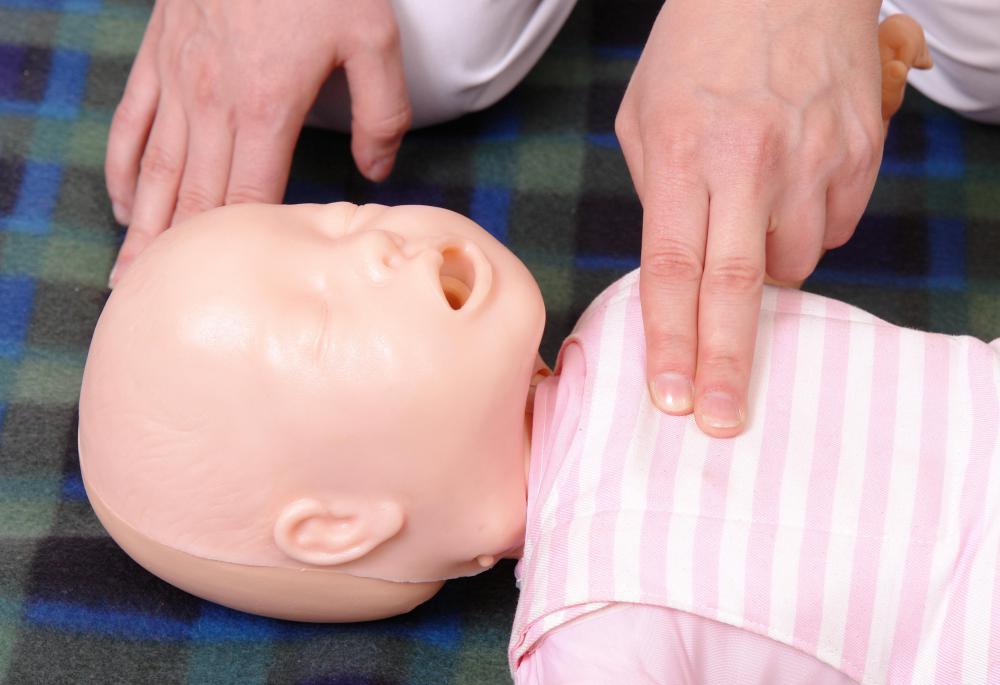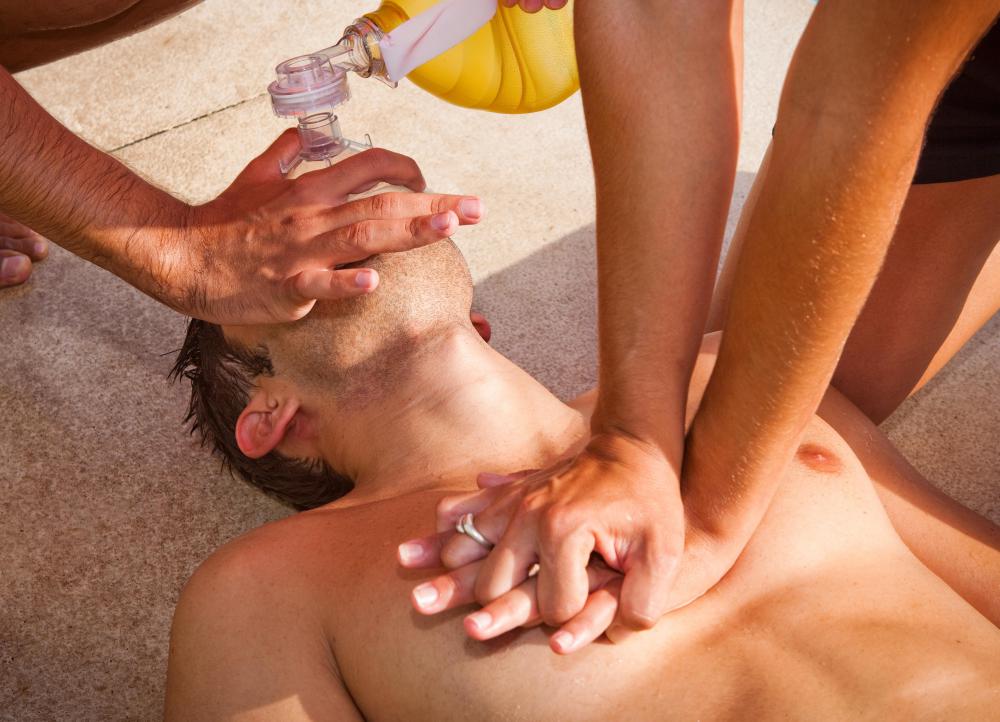At TheHealthBoard, we're committed to delivering accurate, trustworthy information. Our expert-authored content is rigorously fact-checked and sourced from credible authorities. Discover how we uphold the highest standards in providing you with reliable knowledge.
What is CPR?
Cardiopulmonary resuscitation (CPR) is an emergency procedure that is performed on people who are suffering from cardiac arrest. The purpose of CPR is to provide a flow of oxygenated blood to the brain until other procedures can be performed to restore the person's heartbeat and breathing. After more than about five minutes without oxygen, the human brain can suffer permanent damage, so this procedure increases a person's chances of making a full recovery. By itself, CPR is rarely enough for the person to survive, because it typically does not restore the person's heartbeat. Rather, this procedure typically is done as first aid to temporarily keep blood flowing to the brain until emergency responders arrive and can begin treating the person.
Procedures

The main action taken in performing CPR is called chest compressions, which involves pressing down firmly and quickly on the center of the person's chest. Experts say that compressions should be done at a rate of about 100 per minute. When possible, cardiopulmonary resuscitation also involves making sure that the person's airway is clear of obstruction and supplying air to the person's lungs, either by mouth-to-mouth resuscitation or by using a special device that can blow air into the person's mouth. Chest compressions are considered to be more important, and studies have shown that rescue breaths provide minimal benefits. Therefore, experts say that compression-only CPR is sufficient unless the person providing help is well trained in rescue procedures.
Immediate Action

CPR is often used when no other assistance methods, such as defibrillators, are available. It also can be done by medical professionals on patients whose hearts have suddenly stopped beating on their own. Immediate action is considered vital, so people are advised to begin the procedure as soon as possible — even before calling an emergency phone number, if only one person is available to provide help. After one minute of providing CPR, the person helping the victim should call the emergency number or quickly find someone who can, then resume the procedure as soon as possible.
Proper Technique

Someone who is about to perform CPR should make sure that the victim is lying on his or her back and on a relatively firm surface, such as the ground or a floor. The person then kneels next to the victim's upper body and places the heel of one hand on the breastbone in the middle of the victim's chest. The other hand should be placed on top of the first hand. Compressions are done by quickly pressing downward about 2 inches (5.08 cm). The person providing help should keep his or her arms mostly straight and use his or her upper body weight to press downward, rather than using only the arms. Some people maintain a rate of about 100 compressions per minute by counting at a rate of almost two per minute, and others think of a peppy song and press downward with each beat.
Clearing the Airway

When more than one person is available to help, or when the helper is well trained in emergency procedures, rescue breaths can be provided to the victim. Before this can be done, however, the victim's airway should be checked to make sure that it is open and not blocked. His or her head is gently tilted backward and the chin is gently pulled forward to open the mouth and airway. If an object can be seen blocking the victim's airway, it should be removed carefully — great care should be taken not to push the object further down the victim's throat.
Providing Breaths

During mouth-to-mouth resuscitation, the person providing help makes sure that the victim's head is tilted slightly back, then pinches the victim's nose shut, covers the victim's mouth with his or hers and breathes out for one second. A tight seal between mouths will help keep air from escaping, forcing it into the victim's airway. The victim's chest should visibly rise with each breath. Two breaths should be provided after each set of 30 compressions.
A device such as a bag valve mask also can be used to provide rescue breaths. This essentially is a plastic mask that covers the victim's mouth and nose, a plastic bag that fills with air and a soft rubber bulb that can be squeezed to pump air into the victim's mouth. There are other devices that also help with this part of cardiopulmonary resuscitation, such as mouth covers that can be placed on the victim and will help prevent the transmission of germs or diseases during mouth-to-mouth contact.
Children and Babies
When cardiopulmonary resuscitation is performed on children who are 1 to 8 years old, the technique is slightly different. Only one hand should be used to provide chest compressions, and the breaths should be more gentle. Also, if only one person is available to provide help, CPR should be performed for two minutes before stopping to call for help. On babies who are less than 1 year old, only two fingers should be used for the compressions, which should be done by pressing downward for about 1.5 inches (3.8 cm).
Training
Health experts strongly recommend CPR training for teenagers and adults, especially parents and other people who are responsible for watching over children. Classes are offered at many organizations and can be found in most communities for minimal cost or sometimes for free. Someone who has had previous training is advised to take a refresher course about every two years.
Statistics
Although cardiopulmonary resuscitation is often the best option for providing emergency help for someone who is in cardiac arrest, it does not have a high rate of success. The statistics for success rates vary between sources and depend on the circumstances, but even the highest estimates are that less than 30% of people who need CPR survive — and in most cases, it is less than 10%. Generally, the sooner the procedure begins, the higher the likelihood of survival.
Research has shown that chest compressions are often unsuccessful because the person doing them does not use enough force. Some people might be hesitant to use more force because they are afraid of breaking the victim's ribs, which is a potential risk. Experts say that although providing the proper amount of force could result in rib fractures, the benefits of getting the victim's blood to circulate outweigh the potential for injury.
AS FEATURED ON:
AS FEATURED ON:















Discussion Comments
CPR is such a useful thing to know. Once I found a young woman lying face down in the surf. My friend and I dragged her to safety. The woman was unresponsive, not breathing, had no pulse and her mouth was overflowing with water, sand and seaweed. Thanks to my CPR classes, I was able to save the woman's life. I will admit, giving mouth-to-mouth can be quite gross (especially when the victim starts vomiting) but it is a huge achievement to be able to save a life.
I was watching the adult CPR video.
It contains the outdated method of CPR (ABC).
The new method is CAB!
C-Chest Compressions
A-Airway
B-Breathing
The correct method is in your articles.
what should be done if consciousness is regained but the pulse is weak and thready?
when someone's not breathing properly i.e. if the person drowns/is suffering a heart attack or sometimes when the person's choking.
When should someone use CPR?
Post your comments